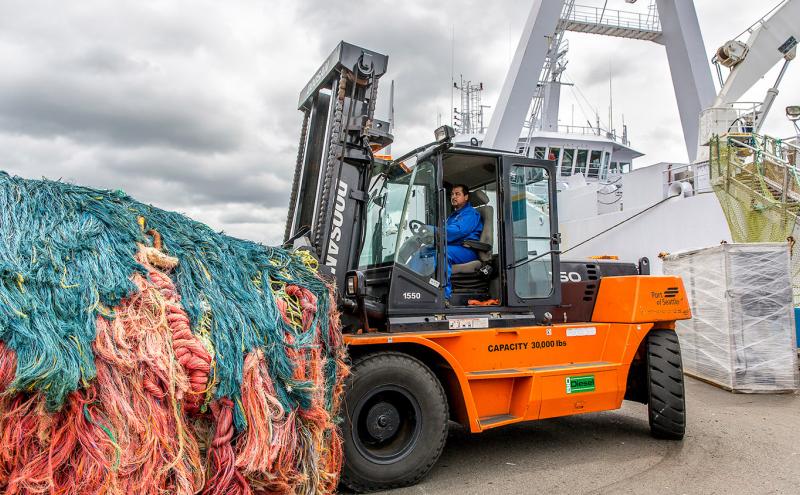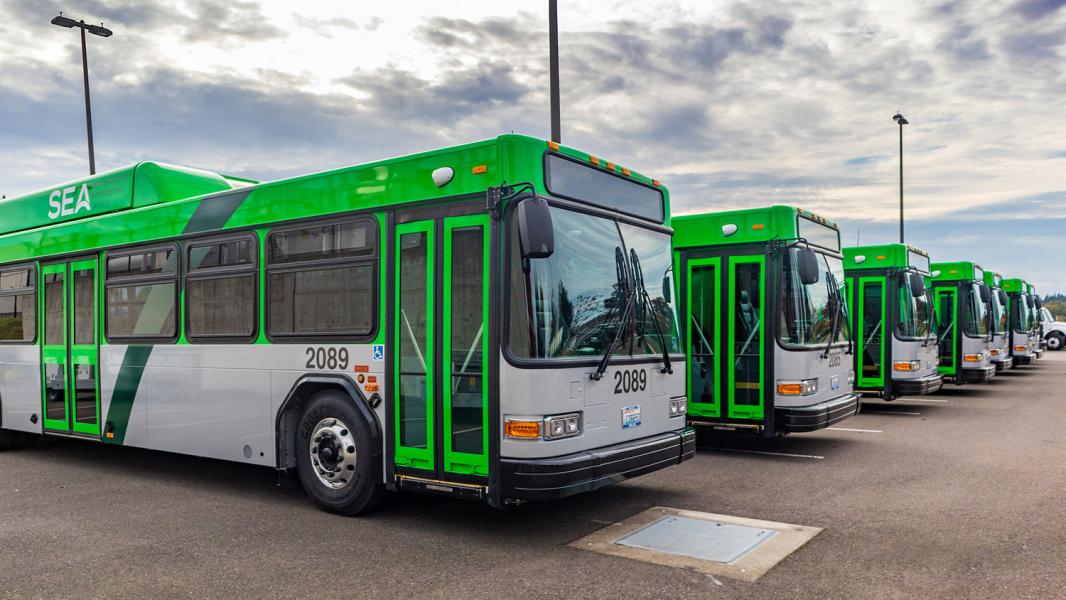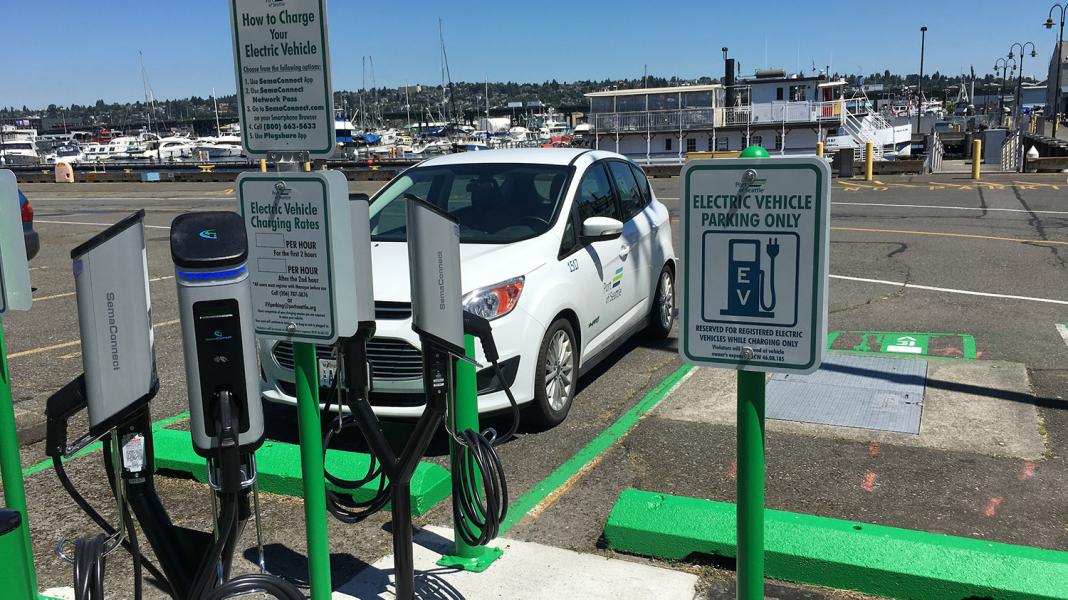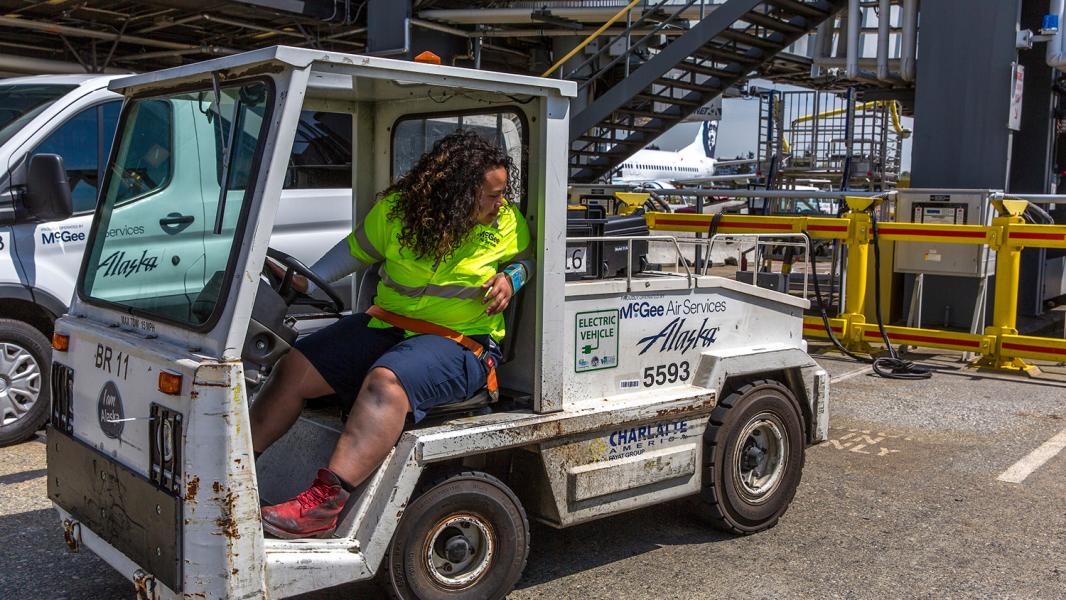
As a leader in moving people and cargo across the country and around the world, the Port of Seattle relies on a fleet of vehicles and equipment to transport employees, passengers, and supplies, maintain properties and assets, and generally keep operations running smoothly.
We know that transportation is our region’s largest source of emissions. Fleet vehicles and equipment, while critical to Port operations, typically run on fossil fuels like diesel, gasoline, and natural gas that produce air pollution and greenhouse gas (GHG) emissions. Fossil fuel use from Port-owned fleet vehicles and equipment accounts for nearly one quarter of all port-owned or controlled emissions.
At the same time, the Port remains committed to the Century Agenda goal of being the greenest and most energy-efficient port in North America. Our world can’t wait, so we are making significant investments in environmental programs now that target the reduction of port emissions.
Our proposed 2022 budget positions the Port to phase out its own emissions in the next 18 years, and support innovation projects that advance decarbonization of the maritime and aviation industries by 2050.
Climate action now
To address the urgency of climate change and its impacts on our operation, customers, community, and environment, the Port of Seattle adopted GHG reduction targets in 2017 to reduce emissions from port-owned or controlled sources by 50 percent by 2030. And recently the Port accelerated our greenhouse gas (GHG) reduction targets to reduce emissions from port-owned or controlled sources to net zero or better by 2040.
One important way to reduce our carbon footprint is to make the Port's vehicle and equipment fleet as sustainable as possible. Over the last 15 years, the Port has:
- Dispensed a 20 percent biodiesel blend at Marine Maintenance fueling sites (from 2008-2019) and began fueling with renewable diesel in 2019
- Dispensed 100 percent renewable diesel at Aviation Maintenance fueling sites starting in 2017
- Fueled the fleet of 45 buses at SEA Airport with renewable natural gas, dramatically reducing emissions from what was previously the largest source of fleet GHG emissions (since 2020)
- Installed electric vehicle (EV) charging stations in the SEA Airport main terminal garage, SEA Cell Phone Lot, Fishermen’s Terminal, and Shilshole Bay Marina. Additional chargers will be installed at the Port’s Marine Maintenance facility in 2022.
Fleet of the future

The Port is also planning to further reduce greenhouse gas emissions from the vehicle fleet, with actions detailed in our new Sustainable Fleet Plan. The Sustainable Fleet Plan proposed actions fulfill our ambitious climate goals while meeting the needs of our customers and maintaining a robust and efficient operation.
The Port currently has over 1,500 vehicles and pieces of equipment that support our daily operations. The fleet includes a range of vehicle and equipment types, from sedans, SUVs, and trucks that employees use to travel between properties and job sites to buses that transport airport passengers, emergency response, and specialized equipment, such as sweepers, heavy-duty lifts, and snow removal equipment for the airfield. The Port’s fleet does not include equipment owned by port tenants or customers, such as airplanes, cruise ships, fishing vessels, or drayage trucks.
Implementing the Sustainable Fleet Plan recommendations could reduce:
- Aviation fleet (vehicles and equipment that serve SEA Airport) GHG emissions by 4,000 metric tons by 2030
- Maritime/Corporate fleets (vehicles and equipment that serve the Maritime, Economic Development, and Central Services divisions) GHG emissions by over 600 metric tons by 2030
These actions together can reduce the Port’s fleet emissions by more than 50 percent by 2030, and demonstrate progress toward the Port’s goal of net zero GHG emissions by 2040.
Here’s a quick look at what is in the new Sustainable Fleet Plan:
1. Plan for electric vehicles

Integrating EVs into our fleet is a key component in cutting Port emissions. To operate more EV passenger vehicles, we need more EV charging stations. Investment in EV charging stations needs to be the first step in supporting the widespread conversion of fleet vehicles and equipment to from fossil fuels to clean electricity.
To plan for EV charging, the Sustainable Fleet Plan recommends the Port complete an EV readiness plan to guide location, charging infrastructure types (e.g., Level 2 versus fast-charging), and timing of charging infrastructure installation across Port properties. This planning effort will allow the Port to evaluate charging needs and prioritize locations for EV charging based on vehicle needs and installation costs. This will also help us prepare for the future deployment of EV trucks and vans that are just starting to become available, and potentially even larger types of vehicles and equipment in the future.
2. Use data to monitor progress
Data is critical to understand current fleet operations and help the Port implement the actions in the Sustainable Fleet Plan. Fleet data collection technology, called “telematics”, can automatically collect information on vehicle use, like mileage, fuel consumption, and vehicle location. This data helps identify vehicles that are not used very much, more efficiently track how well the Port is reducing fleet greenhouse gas emissions, and target purchasing decisions that maximize cost savings and emission reduction.
For example, under current practices, Port drivers enter vehicle mileage information by hand when refueling, which can lead to errors and inaccurate entries that fleet managers have to sort through when analyzing fleet data. Telematics can automate data collection to help fleet managers more accurately and efficiently identify and review vehicles not meeting mileage targets, which could lead to an opportunity to reduce the overall fleet pool size. Telematics can also be used to identify and reduce vehicle idling.
3. Continue to use low-carbon fuels
The Port is already putting low carbon fuels, such as renewable natural gas (RNG) and renewable diesel (RD) to use across its fleet. And it’s no wonder. RNG and RD are easy “drop-in” replacements for conventional fuels—which means that no operational or engine modifications are needed to use them—and they reduce carbon emissions.
The Port plans to continue to use low-carbon fuels throughout our fleet and evaluate new opportunities for usage as new renewable fuels become available. Aviation and maritime fleet managers have already been purchasing RD in place of conventional diesel and SEA uses RNG to power the airport’s bus fleet.
While renewable fuels have historically been more expensive than their conventional counterparts, Washington legislators recently approved a Clean Fuels Program that is expected to reduce costs of low carbon fuels.
The Port will also continue to purchase renewable electricity for SEA Airport to maximize the carbon reduction benefits of EVs.
4. Right-size, modernize, and electrify the vehicle fleet

The Port plans to transition all gasoline-powered light-duty vehicles (sedans and SUVs) to EVs by 2030. As part of this transition, we need to replace older, less efficient vehicles with cleaner, more modern alternatives like EVs. Replacing outdated equipment can save money on operating costs and maintenance while also reducing greenhouse gases and air pollutant emissions. The lower air pollution emissions from modern or electric vehicles can also have a health benefit for Port staff who often work in or near fleet vehicles.
Through a process called right-sizing, the Port replaces existing fleet vehicles with newer, reliable, more fuel-efficient options that can perform the same function. For example, replacing a larger vehicle such as a pickup truck with a smaller vehicle such as a sedan or SUV that also meets the same operational need, can reduce cost in the initial vehicle purchase and over the life of the vehicle by lowering fuel consumption or replacing with a more readily available electric model.
Right-sizing the fleet as a whole involves eliminating vehicles not used very often from the fleet and pooling vehicles across departments to maximize use. Determining the correct number and type of vehicles needed is key. A fleet that doesn’t have the right amount or mix of equipment during peak times could jeopardize operations or require the Port to rent or borrow equipment, causing delays. However, a smaller fleet can save money as every piece of equipment adds cost from the initial purchase and ongoing maintenance. Vehicles that are under-utilized can be removed from the fleet and may not need to be replaced one-to-one.
5. Expand driver training
Believe it or not, driving habits of individual Port employees can make a big difference in emissions. Making small alterations to the way employees drive can lower fuel use and emissions by up to 25 percent. The Port currently requires all employees who use fleet vehicles to complete fleet vehicle safety orientation. Simply adding information on maximizing driving efficiency could have big results. And expanded use of telematics could help quantify which individuals or teams in the fleet drive most efficiently.
Other emissions reduction initiatives at the Port of Seattle include:
- Partnering with the Northwest Seaport Alliance, the Port of Tacoma, and the Port of Vancouver (BC) through the Northwest Ports Clean Air Strategy to phase out seaport-related air and GHG emissions and transition to zero-emission operations within each sector by 2050
- Outlining Port actions to implement the Northwest Ports Clean Air Strategy and meet the Port’s 50% by 2030 GHG reduction target in the Maritime Climate Air Action Plan
- Setting a goal to use sustainable aviation fuels in every flight by 2028
- Electrifying ground support equipment since 2015










